[FRB-CESAB] Newsletter 9 CESAB – July 2023
The FRB’s Center for Biodiversity Synthesis and Analysis (CESAB) is a research structure with an international scope whose objective is to implement innovative work on the synthesis and analysis of existing data sets in the field of biodiversity. Twice a year, the CESAB publishes a newsletter listing the different news and activities going on.
A word from Claire SALOMON, CESAB’s deputy director

Since its creation in 2010 within the Foundation for Biodiversity Research (I was there!), CESAB has passed several milestones. Firstly seen as a non-identified, yet relevant, object by some in the biodiversity research community, CESAB appeared very abstract to others. The first few groups who stayed at CESAB sometimes doubted themselves of the added-value of gathering in “one place, one time for biodiversity research”. Yet, results were quick to emerge and far beyond our hopes! New networks were created, young researchers acquired an international experience, not to mention all the publications at the cutting edge of research. The biodiversity crisis and IPBES have also, unfortunately, shed light on the relevance of synthesis centers, increasing the appeal of the industry and stakeholders. The number of co-funding opportunities, requests and projects grew from year to year, bringing closer together stakeholders and the scientific community and vice versa.
From the 4 initial CESAB groups, we have now reached 30 today, corresponding to a community of 450 researchers of all nationalities spending two weeks a year at CESAB offices. To ensure the best possible working conditions during the entire length of the projects, CESAB is necessarily run by teams from the FRB in Montpellier and Paris, with a new administrative support this year to maintain the same quality of work. CESAB is also a cohort of post-docs, and will welcome four new members at the start of the academic year within the groups ACOUCENE, BIOFOREST, FOOD-WEBS and IMAPCTS. And to keep all this work consistent, CESAB’s scientific committee keeps an oversight and anticipation of the scientific work conducted, the administrative council of the Foundation and its funding members drive the development of the center and give us the means to act via a wide variety of calls for proposals: from the DATASHARE to OPEN calls, not to mention targeted calls.
Two calls opened in the spring including one still open all summer:
- The DataShare call for proposals is open until September 15th, 2023. The objective of this call is to accelerate the sharing of open-access and large-scale ‘novel’ biodiversity related datasets. Four two-year projects, supported by a dedicated data-scientist will hence be funded.
- This call complements classical biodiversity synthesis calls, which aim at fostering the analysis of existing data and the synthesis of ideas and concepts, with a specific focus on data compilation and sharing.
- The third edition of the call “Anthropogenic pressures and impacts on terrestrial biodiversity” closed on June 19th. Three three-year synthesis projects will be funded within this call.
- Meet in early October for the announcement of the pre-selection, and during the first semester of 2024 for the final results.
The seven new projects arising from these two calls will start next year and will be hosted at CESAB.
News from our Cesab groups:
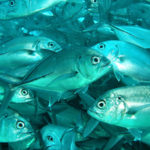
FISHGLOB rewarded!
In early June 2023, FISHGLOB was selected as a project for the United Nations Ocean Decade (UN OD), linked to the UN OD SUPREME program “Sustainability, Predictability and Resilience of Marine Ecosystems”, the latter being led by NOAA (National Oceanic and Atmospheric Administration – USA). This project will run until 2028.
With the support from the FRB, French embassy in Canada, Sea Around Us, Rutgers University and Montpellier University, the group met for a ‘CesabAfter’ during the first week of April in Vancouver, Canada. During the last three years, the group had collected and harmonized a unique set of data coming from scientific trawling operations to study the effect of global change on the biodiversity of demersal species. The CesabAfter then allowed them to focus on the development of a platform strengthening international scientific cooperation and knowledge transfer between dataset holders, experts and managers.
Welcome to our new groups! No less than 22 groups (from 30 active ones) gathered in CESAB offices since the beginning of the year.
- Impacts, Spatman, Landworm and Acoucene, four groups selected from the first edition of the 2021 joint call FRB-OFB-MTE “Impacts on biodiversity in the Anthropocene”, all organized their first meeting;
- Islets, selected from the 2022 Datashare call, met in June. The other Datashare group Phenofish will meet for the first time in the autumn.
- The groups selected from the second edition of the call for proposals “Impacts on biodiversity in the Anthropocene”, Discar, Dragon and Motiver, met the FRB-CESAB team and partners during a kick off meeting on June 15th.
- In early April, the call for participation, led by the Canadian Institute of Ecology and Evolution, selected Zoe LINDO, specialist in soil ecology. Zoe will take part in the second meeting of the group Fauna Services in July. This opportunity is entirely funded by the French embassy in Vancouver, and should be renewed in 2024 and 2025.
- Finally, Nefineo, from the 2021 SYNERGY call for proposals, gathered for its first workshop in Sao Paolo (Brazil). CESAB will welcome the group for its second workshop in November.
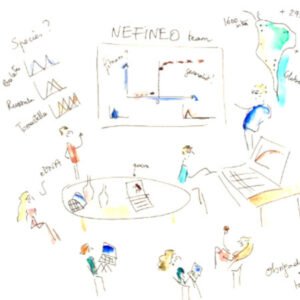
Other activities led within CESAB:
-
CESAB isn’t “just” groups, but also an active team having punctuated the last few months by their events:
- Late March, postdocs, data-scientists, research engineers and interns gathered with the scientific director during a three-day retreat to develop team cohesion and collaborative projects.
- On April 14th, the second part of the QGIS workshop, organized by Marieke SCHULTZ and Marie ORBLIN, geomatics engineers within PARSEC, gathered a dozen of participants.
- On April 20th, CESAB opened its doors to a class of high school students from Jules Guesdes high school (Montpellier) to showcase the different aspects of research undertaken by CESAB’s team.
- Mid-May, the first workshop of the IA-Biodiv challenge brought together the three consortia of the challenge in CESAB offices. Constructive and rich discussions took place on diverse topics, among others biodiversity indicators, data share, and the writing of an opinion paper.
- The group DIVERS, which ended last autumn organized a CesabAfter and will meet in Brittany in October with the help of the CNRS
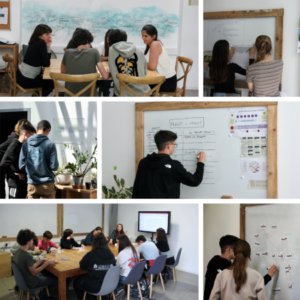
CESAB’s sustained activity will not stop during the second half of 2023, with, among others:
- At least 18 weeks of meetings between July and December
- CESAB’s scientific committee plenary meeting on September 18th
- FRB’s scientific council plenary meeting and workshops on September 27th and 28th
- Two workshops during the autumn, more information below. CESAB will also host a workshop organized by the National Centre for Biodiversity Data (PNDB) in late October
The team is (again!) getting bigger by the end of 2023
- Welcome to Michela BUSANA, who will join Acoucene from July 3rd at CESAB offices!
- Post-docs for the projects BioForest, Food-Webs and Impacts should also be recruited in the next few months, more info in the next newletter
In the meantime, and to face the increasing activities held at CESAB, a new position is opening as administrative support:
- based in Montpellier, one year fixed term contract that may lead to a permanent position
- gross salary starting at 2 301€ per month
- application deadline: July 19th
- link to the job description (in French)
Find more about all CESAB projects
Given the increasing popularity of the workshops, these are becoming regular on an annual cycle. The following workshops will therefore also take place in 2024:
April: Theory-driven Analysis of Ecological Data / second edition from 3rd to 7th April 2023

- The objective of this five-day course is to train young researchers in mathematical modelling and in the statistical links between models and biodiversity data.
- The course gathered 15 participants
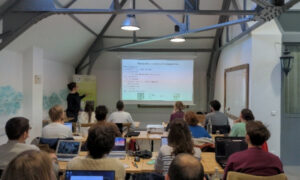
October : La synthèse des connaissances sur la biodiversité: an introduction to meta-analyses and systematic reviews / Second edition from 2nd to 6th October 2023

- This five-day course, organized in collaboration with members from two systematic reviews groups (INDYSEM and AGRI-TE) and PatriNat, and dealing with meta-analyses techniques and methods of systematic reviews applied to the field of biodiversity. Pre-registration is now closed.
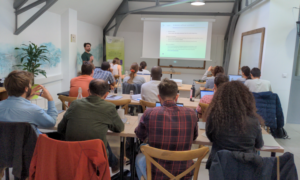
November: Data Toolbox for reproducible Research in Computational Ecology / Fifth edition from November 20th to 24th

- Organized in partnership with the RT Ecostat, this workshop will train young researchers to techniques of reproducibility, software development and version management tools (Git, GitHub, R Markdown, Quarto, renv, Docker), applied to biodiversity research. Pre-registration is now closed.
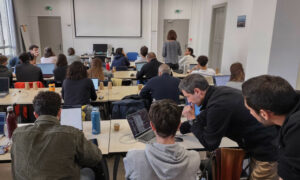
More information about workshops at CESAB

Jonathan LENOIR, member of CESAB’s scientific council, member of a CESAB group and laureate of 2023 CNRS bronze medal revisits with us his activities within and outside of CESAB.
-
Hi Jonathan, can you tell us what your research is about?
My research is about consequences of environmental changes on biodiversity. I’m interested more specifically in species redistribution in response to climatic changes and to human activities. My work uses national or international databases but also data I directly obtain from the field with my colleagues. It is important to remind that data acquisition is a necessary pre-requisite to the gathering and filling of databases that are flourishing everywhere in the world. For example, as an advisor for the northern region of France, I take part in flora inventories of the national network for long-term monitoring of forest ecosystems (RENEFECOR), where the inertia of the changes at stake is the highest. Within forests, I’m interested in the buffer role of trees, which, with their shade and evapotranspiration, maintain a more stable microclimate within the underwood than outside.
-
As a principal investigator of a group and member of two FRB-CESAB projects, how do you see biodiversity data synthesis as a necessary and/or complementary approach to more “classical” research in biodiversity?
As co-PI of BIOSHIFTS and member of RIVAGE, I think of myself as very lucky and privileged. This type of biodiversity data synthesis project allows to bring together a unique set of researchers from the entire world to pool our data and, more importantly, our competences. This to answer society’s increasingly pressing issues, such as biodiversity’s fate in a changing context. By gathering world-leading experts in Montpellier, FRB’s CESAB offers a fertile ground where new ideas can emerge, making CESAB a unique and complementary working environment to more classical biodiversity research.
-
You are also a member of CESAB’s scientific committee, how does the selection process take place?
My role within CESAB’s scientific committee brings me to regularly assess project proposals that have been submitted to the different calls for proposals, such as the DATASHARE, in which I’m more specifically involved. I thereby take part to the selection process of projects among a multidisciplinary panel of other scientists, which sometimes requires the help of external evaluators to help us in this uneasy task to classify projects, each one appearing more interesting than others. As a member of the scientific committee, I still have the possibility to apply to a call for proposals, but in that case, I am of course excluded from the selection process.
-
And tomorrow, any new horizon for research in forest ecology?
In my research perspectives, I’d like to look at micro-climatic processes such as those occurring at the water-forest interfaces, such as riverbanks, which are fragile ecosystems, yet very rich in biodiversity. The buffering power of riverbanks on air and water temperatures is well known, but is also threatened by climate change. Resistance and resilience of this thermic shield faced to climatic variations is a major issue for aquatic or semi-aquatic organisms, mainly ectotherms (fish, amphibians, insects), living in these ecosystems.
More information about Jonathan Lenoir
- [ACTIAS] Toro-Vargas DM, González C, Rougerie R & Amarillo-Suárez AR (2023) Characterization of morphological and biological aspects of venomous caterpillars of the genus Lonomia Walker (Lepidoptera: Saturniidae) in Colombia. PLoS ONE, 18, e0285010. DOI: 1371/journal.pone.0285010.
- [BLUE JUSTICE] Blythe JL, Gill DA, Claudet J, Bennett NJ, Gurney GG, Baggio JA, Ban NC, Bernard ML, Brun V, Darling ES, Di Franco A, Epstein G, Franks P, Horan R, Jupiter SD, Lau J, Lazzari N, Mahajan SL, Mangubhai S, Naggea J, Turner RA & Zafra-Calvo N (2023) Blue justice: A review of emerging scholarship and resistance movements. Cambridge Prisms: Coastal Futures, 1, E15. DOI: 1017/cft.2023.4.
- [BLUE JUSTICE] Gill DA, Blythe J, Bennett N, Evans L, Brown K, Turner RA, Baggio JA, Baker D, Ban NC, Brun V, Claudet J, Darling E, Di Franco A, Epstein G, Estradivari X, Gray NJ, Gurney GG, Horan RP, Jupiter SD, Lau JD, Lazzari N, Lestari P, Mahajan SL, Mangubhai S, Naggea J, Selig ER, Whitney CK, Zafra-Calvo N & Muthiga NA (2023) Triple exposure: Reducing negative impacts of climate change, blue growth, and conservation on coastal communities. One Earth, 6, 118-130. DOI: 1016/j.oneear.2023.01.010.
- [BLUE JUSTICE] Communiqué de presse Blue Justice : Justice bleue : un nouveau mouvement en faveur des communautés côtières, souvent exclues des prises de décision en matière de conservation.
- [DIVERS] Helmstetter AJ, Zenil‐Ferguson R, Sauquet H, Otto SP, Méndez M, Vallejo‐Marin M, Schönenberger J, Burgarella C, Anderson B, de Boer H, Glémin S & Käfer J (2023) Trait‐dependent diversification in angiosperms: Patterns, models and data. Ecology Letters. DOI: 1111/ele.14170.
- [ISLETS] Barton KE & Fortunel C (2023) Island plant functional syndromes and competition with invasive species. Journal of Biogeography. DOI: 1111/jbi.14568.
- [INTRACO] Girard‐Tercieux C, Maréchaux I, Clark AT, Clark JS, Courbaud B, Fortunel C, Guillemot J, Künstler G, Le Maire G, Pélissier R, Rüger N & Vieilledent G (2023) Rethinking the nature of intraspecific variability and its consequences on species coexistence. Ecology and Evolution, 13, e9860. DOI: 1002/ece3.9860.
- [FISHGLOB] Thorson JT, Maureaud AA, Frelat R, Mérigot B, Bigman JS, Friedman ST, Palomares MLD, Pinsky ML, Price SA & Wainwright P (2023) Identifying direct and indirect associations among traits by merging phylogenetic comparative methods and structural equation models. Methods in Ecology and Evolution. DOI: 1111/2041-210X.14076.
- [FORCIS] Chaabane S, De Garidel-Thoron T, Giraud X, Schiebel R, Beaugrand G, Brummer G-J, Casajus N, Greco M, Grigoratou M, Howa H, Jonkers L, Kucera M, Kuroyanagi A, Meilland J, Monteiro F, Mortyn G, Almogi-Labin A, Asahi H, Avnaim-Katav S, Bassinot F, Davis CV, Field DB, Hernández-Almeida I, Herut B, Hosie G, Howard W, Jentzen A, Johns DG, Keigwin L, Kitchener J, Kohfeld KE, Lessa DVO, Manno C, Marchant M, Ofstad S, Ortiz JD, Post A, Rigual-Hernandez A, Rillo MC, Robinson K, Sagawa T, Sierro F, Takahashi KT, Torfstein A, Venancio I, Yamasaki M & Ziveri P (2023) The FORCIS database: A global census of planktonic Foraminifera from ocean waters. Scientific Data, 10, 354. DOI: 1038/s41597-023-02264-2.
- [FORCIS] Knecht NS, Benedetti F, Elizondo UH, Bednaršek N, Chaabane S, de Weerd C, Peijnenburg KTCA, Schiebel R & Vogt M (2023) The impact of zooplankton calcifiers on the marine carbon cycle. Global Biogeochemical Cycles. DOI: 1029/2022GB007685.
- [FREE] Cutts V, Hanz DM, Barajas‐Barbosa MP, Schrodt F, Steinbauer MJ, Beierkuhnlein C, Denelle P, Fernández‐Palacios JM, Gaüzère P, Grenié M, Irl SDH, Kraft N, Kreft H, Maitner B, Munoz F, Thuiller W, Violle C, Weigelt P, Field R & Algar AC (2023) Links to rare climates do not translate into distinct traits for island endemics. Ecology Letters. DOI: 1111/ele.14169.
- [FREE] Gaüzère P, Blonder B, Denelle P, Fournier B, Grenié M, Delalandre L, Münkemüller T, Munoz F, Violle C & Thuiller W (2023) The functional trait distinctiveness of plant species is scale dependent. Ecography, 2023, e06504. DOI: 1111/ecog.06504.
- [FREE] Munoz F, Klausmeier CA, Gaüzère P, Kandlikar G, Litchman E, Mouquet N, Ostling A, Thuiller W, Algar AC, Auber A, Cadotte MW, Delalandre L, Denelle P, Enquist BJ, Fortunel C, Grenié M, Loiseau N, Mahaut L, Maire A, Mouillot D, Pimiento C, Violle C & Kraft NJB (2023) The ecological causes of functional distinctiveness in communities. Ecology Letters, 00, 1– 14. DOI: https://doi.org/10.1111/ele.14265
- [FUNCTIONAL WEBS] Srivastava DS, MacDonald AAM, Pillar VD, Kratina P, Debastiani VJ, Guzman LM, Trzcinski M, Dézerald O, Barberis IM, de Omena PM, Romero GQ, Ospina‐Bautista F, Marino NAC, Leroy C, Farjalla VF, Richardson BA, Gonçalves AZ, Corbara B, Petermann JS, Richardson MJ, Melnychuk MC, Jocqué M, Ngai JT, Talaga S, Piccoli GCO, Montero G, Kirby KR, Starzomski BM & Céréghino R (2023) Geographical variation in the trait‐based assembly patterns of multitrophic invertebrate communities. Functional Ecology, 37, 73-86. DOI: 1111/1365-2435.14096.
- [PELAGIC] Letessier TB, Mannocci L, Goodwin B, Embling C, de Vos A, Anderson RC, Ingram SN, Rogan A & Turvey ST (2023) Contrasting ecological information content in whaling archives with modern cetacean surveys for conservation planning and identification of historical distribution changes. Conservation Biology. DOI: 1111/cobi.14043.
- [CESAB members] Fromentin J-M, Emery MR, Donaldson J, Balachander G, Barron ES, Chaudhary RP, Danner M-C, Gasalla MA, Hallosserie A, Halmy M, Hicks C, Kieling D, Park MS, Parlee B, Rice J, Ticktin T & Tittensor D (2023) Status, challenges and pathways to the sustainable use of wild species. Global Environmental Change, 81, 102692. DOI: 1016/j.gloenvcha.2023.102692.
- [CESAB members] Tribot A-S, Blanc N, Brassac T, Guilhaumon F, Casajus N & Mouquet N (2023) What makes a teddy bear comforting? A participatory study reveals the prevalence of sensory characteristics and emotional bonds in the perception of comforting teddy bears. The Journal of Positive Psychology. DOI: 1080/17439760.2023.2170273.
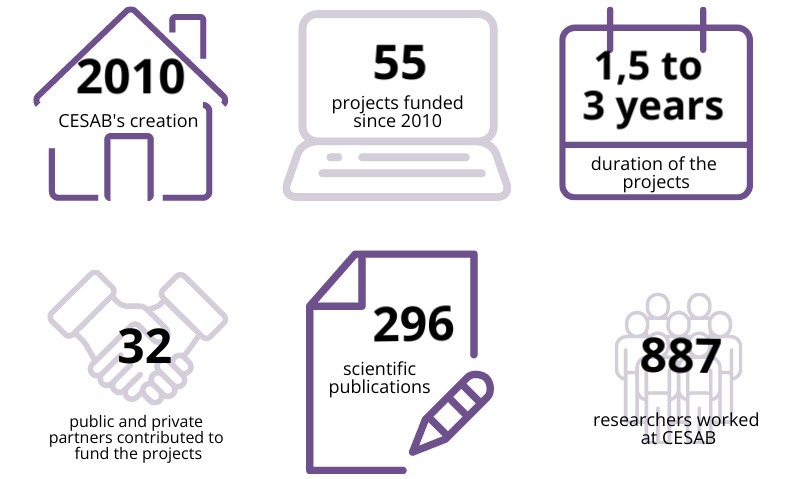
- A bustling first semester, punctuated by new calls for proposals, the visit of many groups and the arrival of new ones!
- A second semester full of events and new arrivals
- Courses at CESAB now on a rolling basis
- Spotlight on a CESAB researcher Jonathan Lenoir
- Last CESAB publications
- CESAB in a nutshell